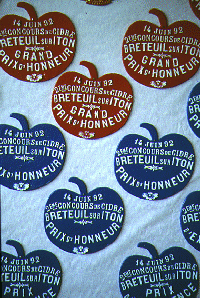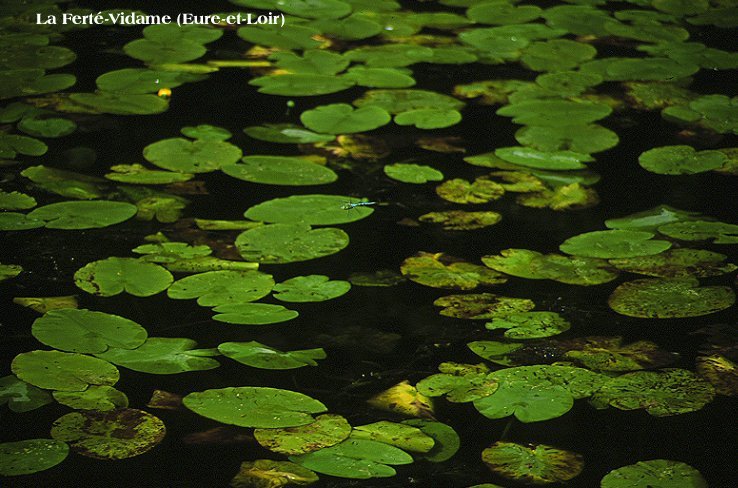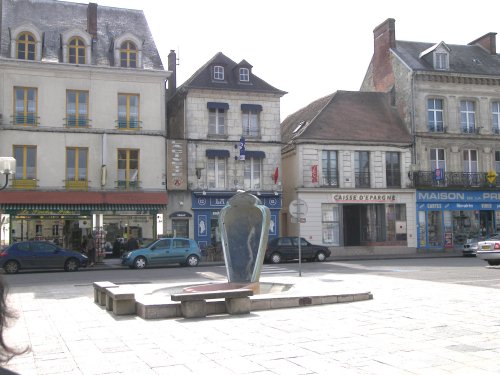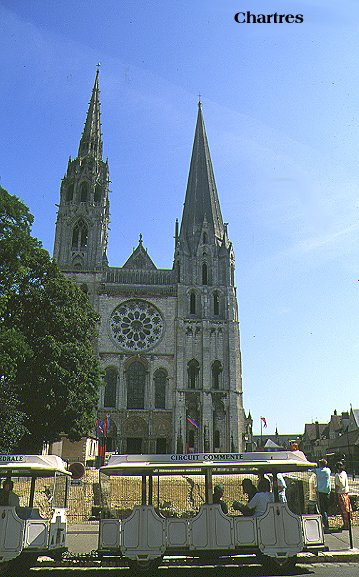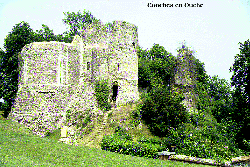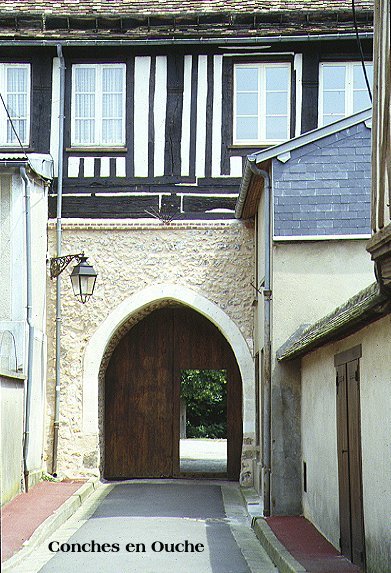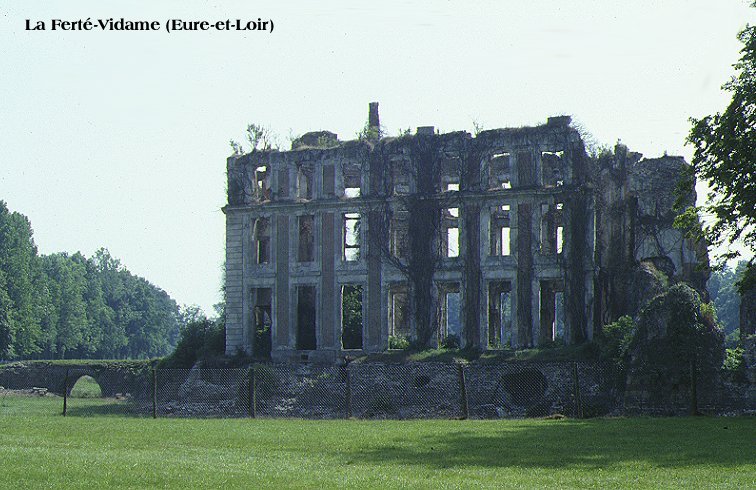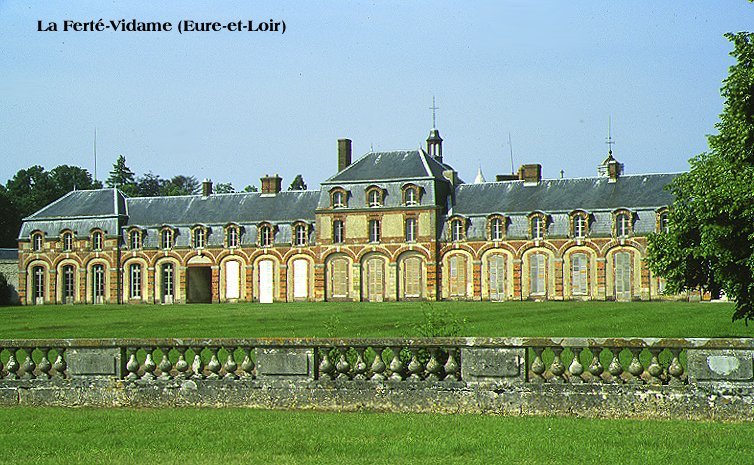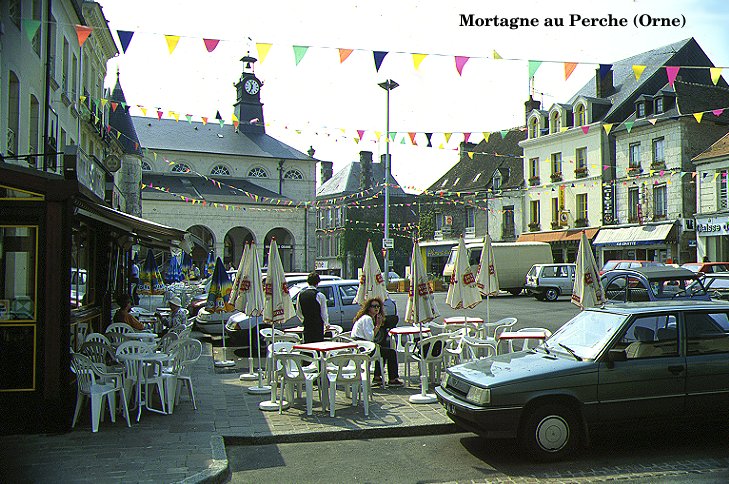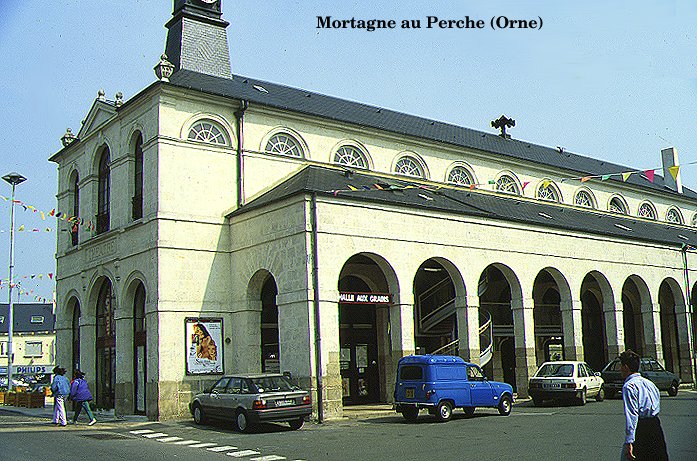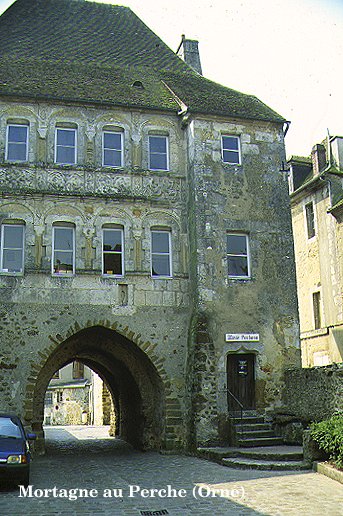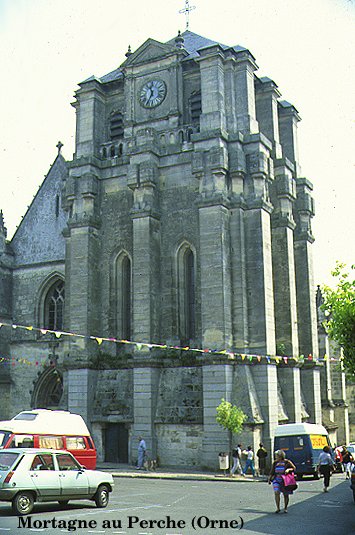|
Normandy: a postcard from
Le Perche View this as a slide presentation: click here
|
||
| Arrived Caen/Ouistreham 0700 french time as
planned. Breakfast in Houlgate 0800 as planned. I stopped in the main street of Houlgate at eight o'clock and went into a spotless little bar for my breakfast. It was a cool, misty June morning, so I chose a seat at the back of the bar in a sort of snug near the babyfoot machine. Just as I sat down a bunch of teenagers came in, making of course immediately for my corner. I got up and moved into the main body of the bar, for which they thanked me. Unfortunately, it turned out there were too many lads and lasses to fit into the snug, so the proprietor started putting tables together near me; amid profuse apologies from all concerned, I moved back into the corner. I was brought a vast cup of coffee and a big jug of milk, and a basket with two buttery croissants nestled snugly into it. The teenagers sat down at their tables and ordered coffee. Some of them asked for croissants, others arranged to send a girl down to the bakery for bread. While she was gone, five of the boys came into my corner for a game of babyfoot. All this, let me add, in the utmost decorum; they smiled politely, banged the babyfoot table about in a genial manner, treated each other with a certain jolly courtesy, and made probably less noise than a group of adults might. I am still trying to work them out. Where in England or the USA could you go to a local caff at eight on a Sunday morning and find so much as one teenager awake? Where in Europe could you find two dozen teenagers capable of behaving themselves at table, or meeting for a communal breakfast? As a first event on a trip to France it was certainly unique to its setting. Houlgate to Deauville, to Pont-l'Éveque to Pont-Audemer to Bernay.
On to Broglie, La Barre en Ouche, Vieille lyre, Conches en Ouche. At Conches, amazing castle ruins behind charming hotel de ville and gardens. Restaurant À la Saint-Jacques opened late, but was worth waiting for. Snapped the baroque windows in the church while waiting. At the artisanat centre, a small shop has a spiral staircase in its floor, which leads down to a whole series of medieval vaulted cellars stuffed with pottery and wrought iron work. The house itself is old Norman with colombages half-timbering and the forge is in the back garden. Makes door furniture, fire-irons, gates, window grilles, girouettes (weathercocks), some sculpture; rarely open to public, but when the second son is through his national service they may be able to open the forge to view daily. They were making fire-irons, pokers and prodders for log fires today, as being something the public can see started and finished in a short time. Lady in shop eager to discuss artisanat; in France not theatre or museum, certainly not folklore; this is a genuine living craft from which a living is still to be made.
La Ferté-Vidame, Senonches, la Loupe, Mortagne. A great deal of our knowledge of the court of Louis XIV comes from the memoirs of the Duc de Saint-Simon. His country estate was at La Ferté-Vidame, though he rarely actually went there; it was the genius if Louis XIV that he persuaded his nobles to prefer life at a crowded, smelly Versailles to the immense luxury of their actual homes. Nevertheless, when the ducal château burned down, a new one was built immediately though, curiously, without actually demolishing the old, whose skeletal remains still stand in the park. The later castle is surrounded by a broad moat covered in water-lilies; I spent a peaceful hour just watching dragonflies.
Mortagne au Perche Those of us who grew up with the French text-books of W.F.H. Whitmarsh will remember François, the old peasant with what would nowadays be regarded as a somewhat unhealthy interest in young children, and who lived in a small town called Mortagne. He had, I remember, a cat called Mistigri. There are towns called Mortagne all over France, but the best candidate for Whitmarsh's immortalisation is surely this one, in the centre of a region entirely devoted to peasant farming.
Behind the Hotel de Ville of Mortagne is, as one might expect, the Jardin Municipal, at the end of which an area partly given over to the local bus station boasts a balustrade overlooking what is announced as a panorama. Few things in this town disappoint, but the panorama is one of them. At the end of the garden also is a strange bronze by Frémiet, representing the infant Neptune on a horse. The inscription on the base assures us that Ceres is there as well, but I couldn't find her. The town's brochures also insist that the horse is a Percheron; if thats so, the Percheron has developed and doubled in weight since Frémiet's day (1824-1910). On closer inspection, this appears to be the same horse as the one bearing Joan of Arc in the Place des Pyramides in Paris, a far more impressive piece of work by the same hand. The proportions of this thing are all wrong; a tiny armoured putto with a vast trident on a life-size horse. Have we lost a full-size Ceres? Did she in some way offend the local worthies with her shameless fertility in their back garden, and was removed one midnight and her memory suppressed?
All these hilltop towns were fortified once, and Mortagne retains one of its gates, the Porte Saint-Denis. Next to it is the church of Notre-Dame, with a ridiculously solid Renaissance tower and a ridiculously over-decorated flamboyant vault. Mortagne seems to have achieved its greatest prosperity at just the wrong moment in the history of church architecture. The nicest building I saw at Mortagne was a school; the Lyce-College Bignot, one of those organic structures which has been added to and rabbit-warrened over a period of centuries, with a charming entrance courtyard that would grace any chateau. Of course, education in France is as old as the nobility, and nowadays far more respected. Only fair that it should inhabit the same sort of buildings. In England, of course, where education is not respected at all, the place would have been condemned as unsuitable to its purpose years ago, and probably demolished to make way for something with a flat roof and brick corridors. There must be somebody who calls it progress.
Looking for a shady picnic place between Chartres and Chateaudun, I stumbled on ALLUYES, one of those sudden enchantments that hide round the corners of rural France. This was once the seat of one of the five baronies of southern Perche, with an enormous château inhabited by a baron with the wonderful name of Florimond Robertet. All that remains of the castle now is a ruined chapel, the massive keep, a single gateway with its bridge, and the moat. The moat winds through the village green, all water-lilies and willows and marigolds, crossed here and there by little bridges. The keep towers above it all, perhaps a hundred feet high, grim and grey. And at a corner of the green a splendid little church offers three gables and a steeple to the embrace of the sun. When I arrived in Alluyes, there was obviously something about to happen. It turned out to be an old folks' boules tournament. I'm watching it now. It's magical. There's one grey-bearded man playing with what I'll swear are real cannon-balls; red with rust and pitted with age, probably a little something his grandfather picked up at Austerlitz. There are ten games going on at once, nobody seems to know quite who is playing whom, let alone who's winning; but then, nobody minds either. There are as many spectators as players, they've all brought their own garden chairs, there's a hessian awning over a little open-air bar. One old lady is obsessively cutting blossoms off the surrounding trees. You're right, its a little corner of heaven.
|
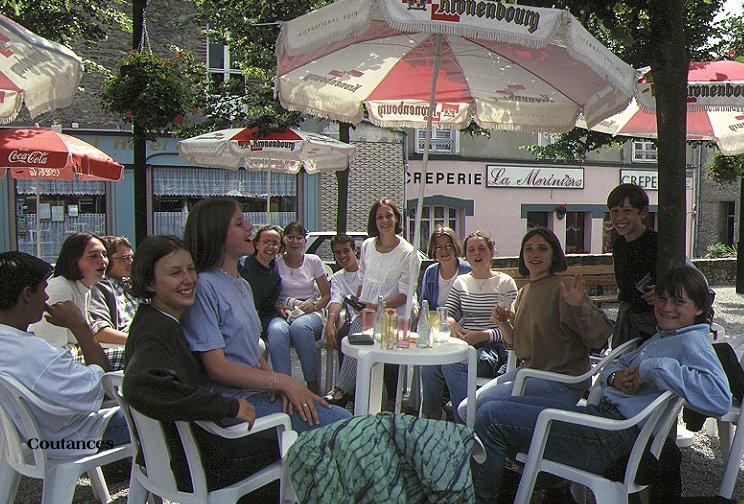
Bernay: Salon du Meuble Normand Held in the old abbey, typical benedictine romanesque on the verge of Gothic; south aisle a series of domes, north aisle vaulted; all very high, helped by floor being as usual below ground level. Pale stone similar to Loire tuffeau, but probably local chalk. The meubles themselves were amazing; mostly pure Norman, in oak, dating from the early eighteenth to the late nineteenth century. Two types; buffet and armoire. The buffet is a sideboard; it comes in top and bottom, sometimes equal in size, sometimes smaller at top. The armoire (left) is a linen-cupboard, shelved with two vast doors. Both are usually four or five feet wide, seven feet high. Some examples of the Ile de France and Sarthe varieties in merisier, none of the North Norman pine or the rare Dieppe/Fécamp mahogany which fetches the lowest price of all because nobody believes it can be authentic. Photographed two sets; one early 18th century from Coutances, called a quatre volets - 4 square panels to each meuble. Buffet 48,000F; armoire 37,000. Second set from Vire, where there used to be a school for carvers; highly decorated with ribbons, hearts and pearls; the central panel with garden tools entwined with grapes symbolic of the intoxication of love, made for the same dowry in 1830 or so, they somehow found their way across France to Besançon, where they were split up and sold separately in 1970. Somehow, through a series of deals, they both found their way back to Normandy, where two separate dealers thought them worth of inclusion in this exhibition, and they were snapped up by the same buyer. These things come with a history, authenticated by notaires. Price undisclosed, but probably similar to other set, perhaps a little more. Pine variants come at about a third of these prices if fine.
On to Breteuil sur Iton. Cider fair in progress, judging going on; lovely ponds in grounds of dead castle. Verneuil; supposed to a be flower-arranging festival, but all hidden by vast crowds at grande braderie. This is a second-hand sale, enormously popular with thrifty Normans.
From Perche to Beauce A friend of mine was motoring in central France some years ago, when he suddenly had one of those Proustian moments. Marcel Proust, remember, dipped a madeleine in his tea and found that the taste brought back all the memories of his childhood in a village he called Combray. My friend drove down a French road and suddenly found himself remembering all Proust's memories. Round the next corner he came on the village of Illiers, the original of Combray, which since those days has added its fictional name to its real one. Illiers-Combray is the gateway between Perche and Beauce. That's why young Marcel Proust had two ways to go; du côté de chez Swann was bourgeois, rich, prosperous, essentially beauceron; the Guermantes way was aristocratic, horsy, ancient but a bit shabby; the soul of the Perche. Most of Illiers belongs to Swann nowadays; the memory of Proust brings in the tourists and the tourists bring in the money. There's a beautifully-paved pedestrian area round the old church, and the way to Aunt Sophie's house is well signposted. The Jardin du Pré-Catelan, where young Marcel used to walk, is the town park now, free to enter and not too carefully managed. There is a choice of walks; the hilly paths through the woods, or the smooth, well-tended valley. Which would Marcel have taken? I decide that, being Marcel Proust, he would have taken the valley walk while inventing secret mountains in his mind.
|
|

